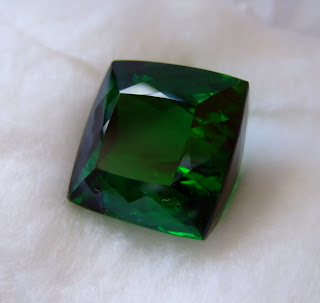

Let's talk about these two beauties.
The first one, at the top (or on the left, depending on how your browser displays this page), is actually green going into blue-green. It is a good 2 inches long. If you were to buy it for yourself, all well and good. But if you are buying it to resell, what to do? What types of clients do you have? For example, what is a jeweler going to do with such a long stone? Really, it is too long to put in a ring. Should it be set into a pendant? I dunno. A pendant would not really show off the beauty of this stone. What about a brooch? Do you have jeweler clients who specialize in making brooches? Hmmm. This leaves you with thinking about your clients who are collectors and who are not interested in setting this stone. It is a marvelous example of a flawless bicolor tourmaline that goes from green into blue-green.
OK, now let's have a look at the second stone on the right (or below). This beauty has even more problems than the first one. This stone is so large that it is next to impossible to set (if I remember correctly, it was somewhere between 40 and 60 carats). This leaves it for a collector. But look at the cut. Look at the table. Hellooo! Really nice window to the bottom, isn't it!
You could have the stone recut as a round, but it might still be way too large to put in a ring, unless you are willing to lose a lot of carat weight. And for that, you need to pay a low-enough per carat price, because basically we are talking about rough here now, aren't we?
This stone is a perfect example of the prevailing tendency (by the less sophisticated dealers) here in Brazil to cut the stone as large as possible. This is called to aproveitar the stone (or to "take advantage" of the stone). They will have the stone cut as large as possible while still avoiding inclusions. Some of the really unsophisticated sellers will have the stones cut even larger and include inclusions in the belief that size is more important than an obvious flaw.





Next time you visit Rio or the other major Brazilian cities, check out H Stern's window display. In the last couple of years, they have showcase some very badly cut stones, with lopsided geometry and huge windows, with very high price tags (US$15k and up). Washed out colours as well.
ReplyDeleteIt is unfortunate that such stones are making their way up the food chain, specially at higher end stores.
A couple of years ago, H. Stern had these earrings of some of the worst tourmalines I have ever seen -- so bad, in fact, that I wondered where the heck they had been purchased.
ReplyDeleteBut in Brazil, many unenlightened customers want to purchase something with the H. Stern name.
The other thing is that most Brazilians are woefully informed about their own native gemstones. I would wager that 95 out of 100 Brazilians do not know that tourmalines come in any color other than green.